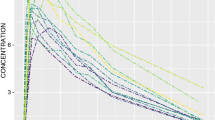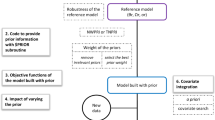Abstract
When modeling new data with a complex population pharmacokinetic/pharmacodynamic model, there may not be sufficient information to obtain estimates of all parameters. In this case information from previous studies can also be used to help stabilize estimation. Using simulated data, we explored three different ways to do this. (i) Some parameter values were fixed to estimates obtained from earlier data. (ii) The earlier data were combined with the current data. (iii) The objective function based on the current data was augmented by a penalty function expressing summary information obtained from the earlier data. This last method is similar to the use of a Bayesian prior. It may be particularly useful when either the combined data set of method (ii) is very large and leads to large computation times or when the early data are not readily available. With this method, two different types of penalty functions were used. With our examples, the three methods all resulted in stabilized estimation. Methods (ii) and (iii) gave similar results for parameter and standard error estimation, especially with respect to fixed effects parameters. For hypothesis testing, results obtained with method (i) are very problematic. There are also problems with the results obtained with method (iii), but they are much less severe, and when the design for the earlier data is known, they can be corrected by using a computer-intensive simulation test procedure.
Similar content being viewed by others
REFERENCES
L. Yuh, S. L. Beal, M. Davidian, F. Harrison, A. Hestor, K. Kowalski, E. Vonesh, and R. Wolfinger. Population pharmacokinetic/pharmacodynamic methodology and applications: A bibliography. Biometrics 50:566–575 (1994).
J. R. Wade, S. L. Beal, and N. C. Sambol. Interaction between structural, statistical, and covariate models in population pharmacokinetic analysis. J. Pharmacokin. Biopharmaceutics 22:165–177 (1994).
J. R. Wade, A. W. Kelman, C. A. Howie, and B. Whiting. Effect of misspecification of the absorption process on subsequent parameter estimation in population analysis. J. Pharmacokin. Biopharm. 21:209–222 (1993).
R. Bruno, N. Vivier, J. C. Vergniol, S. L. D. Phillips, G. Montay, and L. B. Sheiner. A population pharmacokinetic model for docetaxel (taxotere): Model building and validation. J. Pharmacokin. Biopharm. 24:153–712 (1996).
L. E. Simonsen, U. Wahlby, M. Sandstrom, A. Freijs, and M. O. Karlsson. Haematological toxicity following different dosing schedules of 5-fluorouacil and epirubicin in rats. Anticancer Research 20:1519–1525 (2000).
S. L. Beal and L. B. Sheiner. Methodology of population pharmacokinetics. In E. R. Garrett and J. L. Hirtz (eds.), Drug Fate and Metabolism: Methods and Techniques, vol. 5, Marcel Decker, New York, 1985, pp. 135–183.
T. M. Ludden, S. R. B. Allerheiligen, and R. F. Bank. Application of population analysis to physiological pharmacokinetics. J. Pharmacokin. Biopharm. 19:101S-113S (1991).
A. Gelman, F. Bois, and J. Jiang. Physiological pharmacokinetic analysis using population modeling and informative prior distributions. J. Am. Stat. Assn. 91:1400–1412 (1996).
S. L. Beal and L. B. Sheiner. NONMEM Users Guides (I-VIII). Hanover, Maryland: GloboMax, 1989–1998.
S. L. Beal and L. B. Sheiner. NONMEM Users Guide-Part VII: Conditional Estimation Methods. Hanover, Maryland: GloboMax, 1992–1998.
N. L. Johnson and S. Kotz. Distributions in Statistics: Continuous Multiûariate Distributions. John Wiley and Sons, New York, 1972.
J. Wakefield. The Bayesian analysis of population pharmacokinetic models. J. of the American Statistical Association 91:62–75 (1996).
G. E. P. Box and G. C. Tiao. Bayesian Inference in Statistical Analysis. Addison-Wesley, New York, 1973.
J. C. Wakefield, A. F. M. Smith, A. Racine-Poon, and A. E. Gelfand. Bayesian analysis of linear and nonlinear population models using the Gibbs sampler. Appl. Stat. 43:201–222 (1994).
D. R. Cox and D. V. Hinkley. Theoretical Statistics. Chapman and Hall, London, 1974.
U. Wahlby, E. N. Jonsson, and M. O. Karlsson. Assessment of significance Levels for covariate effects in NONMEM. J. Pharmacokin. Pharmacodyn. 28:231–252 (2001).
S. L. Beal. Commentary on significance levels for covariate effects in NONMEM. J. Pharmacokin. Pharmacodyn. 29:403–410 (2002).
Y. Yano, S. L. Beal, and L. B. Sheiner. Evaluating pharmacokinetic_pharmacodynamic models using the posterior predictive check. J. Pharmacokin. Pharmacodyn.28:171–192 (2001).
Author information
Authors and Affiliations
Rights and permissions
About this article
Cite this article
Gisleskog, P.O., Karlsson, M.O. & Beal, S.L. Use of Prior Information to Stabilize a Population Data Analysis. J Pharmacokinet Pharmacodyn 29, 473–505 (2002). https://doi.org/10.1023/A:1022972420004
Issue Date:
DOI: https://doi.org/10.1023/A:1022972420004




